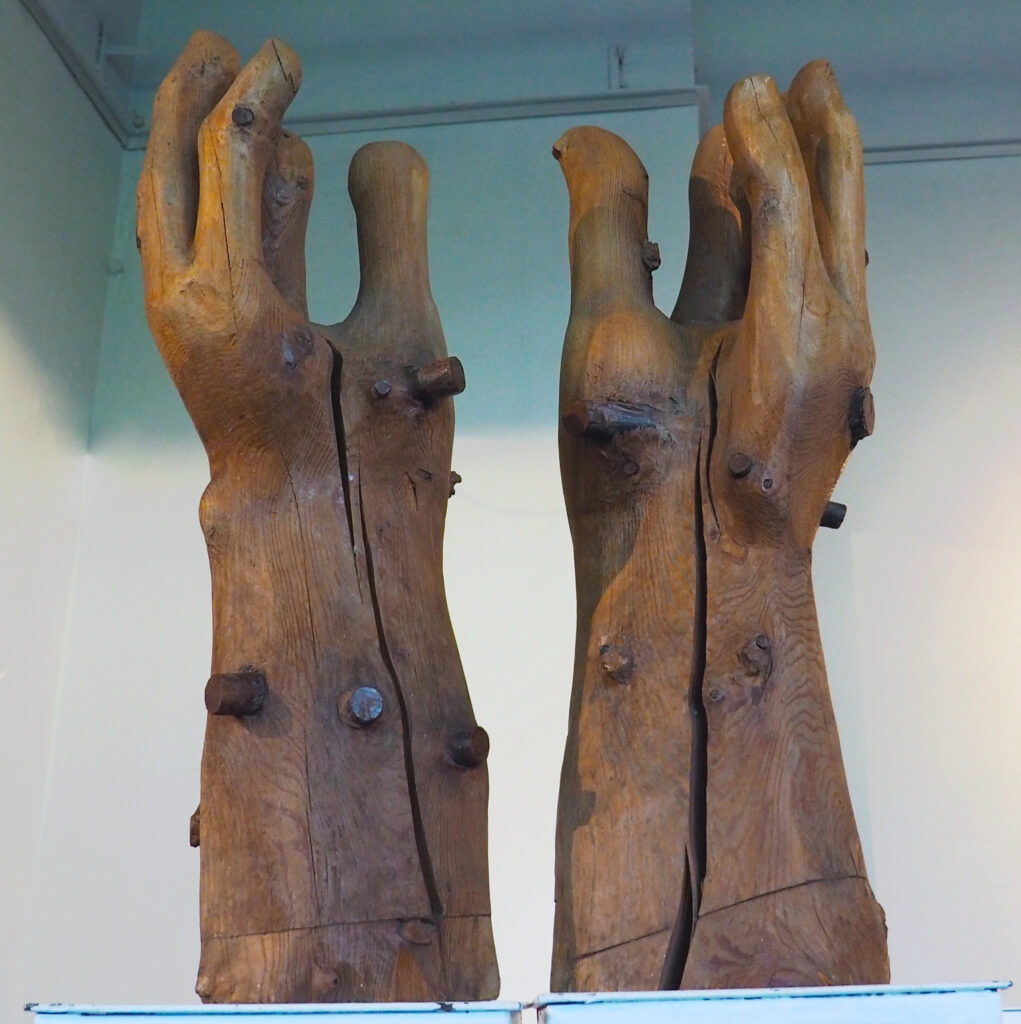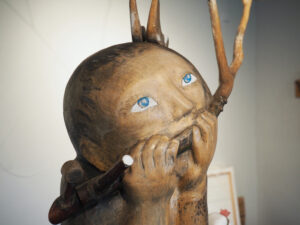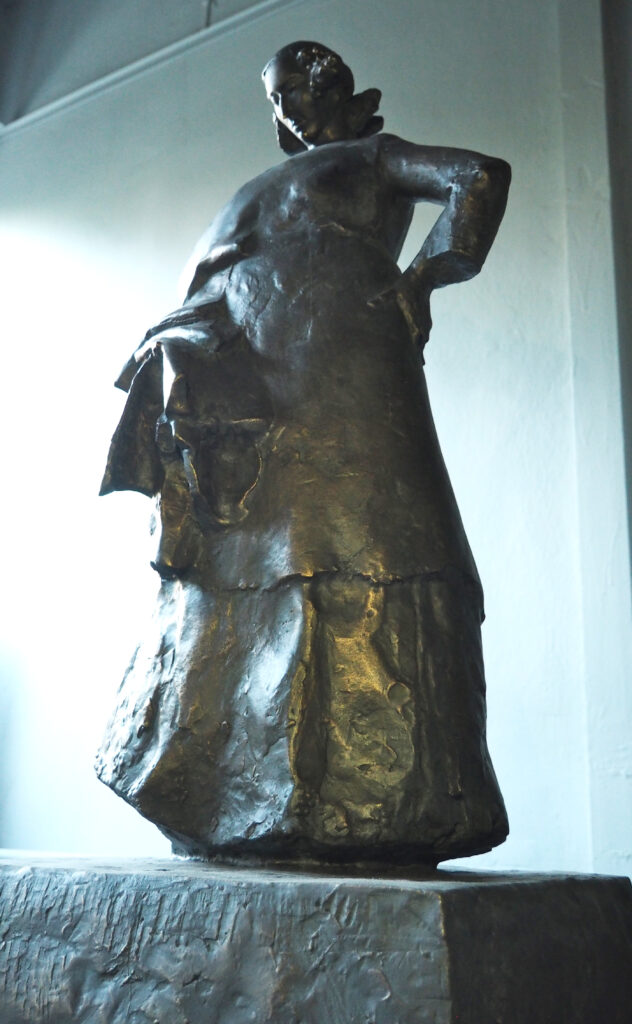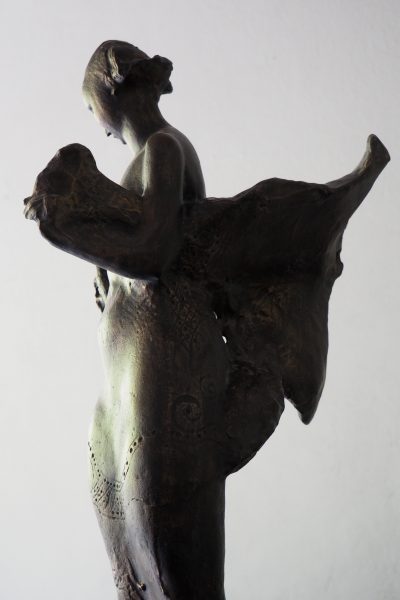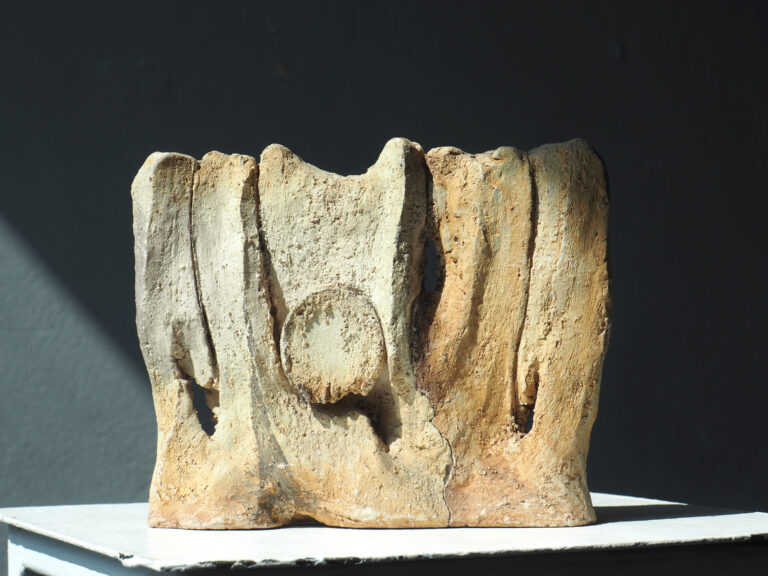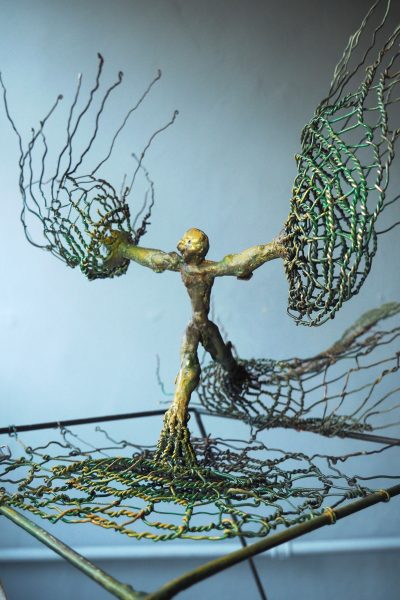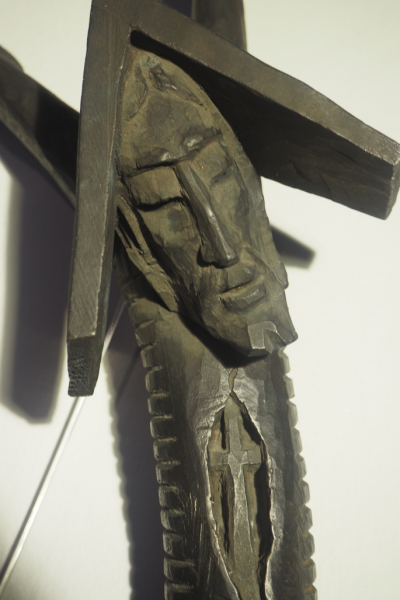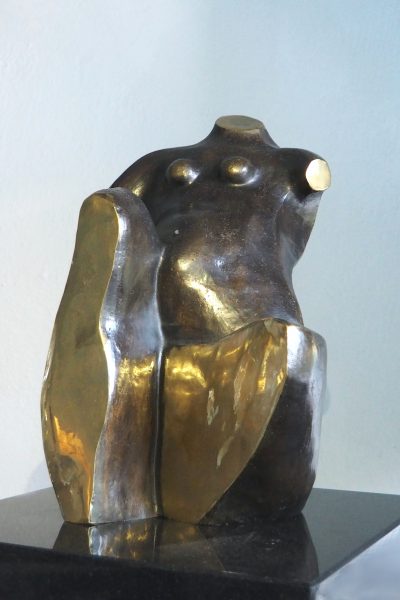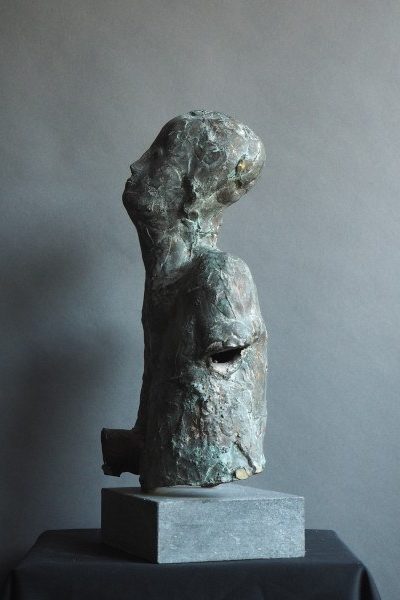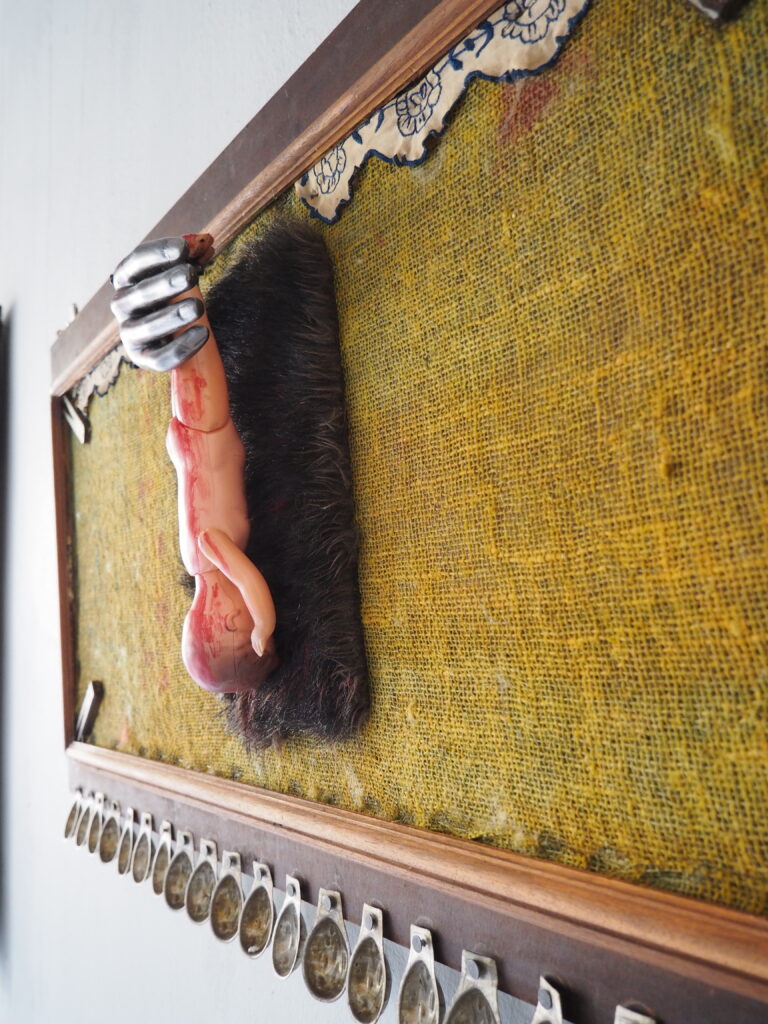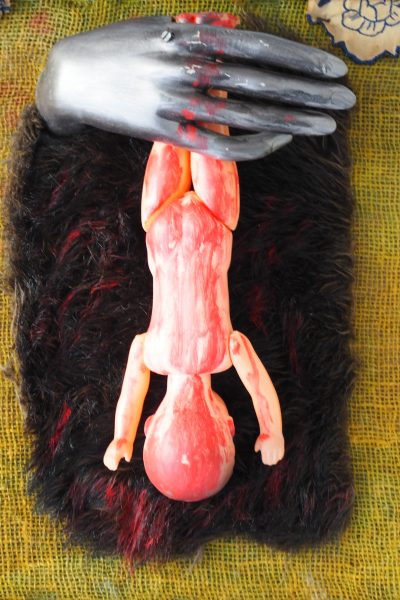MASTERS OF SCULPTURE
4.08.2022 – 18.08.2022
ARTISTS
PROF.
STANISŁAW KULON
Stanisław Kulon urodził się 26 sierpnia 1930 roku na Kresach, we wsi Siółko (Sobiesko). Jako dziecko został przymusowo wywieziony na Syberię wraz z rodziną. Sześć lat później wrócił do kraju. Drogę artystycznej edukacji rozpoczął w Liceum Sztuk Plastycznych im. Antoniego Kenara w Zakopanem. Kontynuował ją na Wydziale Rzeźby Akademii Sztuk Pięknych w Warszawie – w pracowniach Ludwiki Nitschowej oraz Mariana Wnuka. Dyplom otrzymał w 1958 roku. Będąc jeszcze na studiach, wyraził swój sprzeciw wobec skazy historii XX-go wieku – uczestniczył w wystawie ,,Przeciw wojnie, przeciw faszyzmowi”. Aktywność twórczą sukcesywnie łączył z pracą naukową oraz akademicką. Jego ulubionym materiałem była ceramika. Szczególnie lubował się również w rzeźbie monumentalnej. W jego dziełach z łatwością daje się dostrzec sakralny pierwiastek, aluzje do chrześcijaństwa. Na przełomie lat pięćdziesiątych i sześćdziesiątych działał jako asystent w pracowni Nitschowej. Wspinając się po szczeblach uniwersyteckiej struktury, w 1988 roku, uzyskał tytuł profesora nadzwyczajnego na wspomnianym już Wydziale Rzeźby. Dwukrotnie sprawował również funkcję prodziekana. Od 1964 roku współpracował z grupą ,,Rekonesans”. Profesorem zwyczajnym stał się w 1995 roku, zaś pięć lat później odszedł na emeryturę. Jest autorem kilku pomników – rozsianych po Warszawie (Pomnik Marii Konopnickiej, Złota kaczka), a także w świętokrzyskim (Pomnik Bohaterom Starachowic), we wsi nad rzeką Wkrą (Pomnik Poległym) czy też na Słowacji (Matka). Ma w swoim dorobku wystawy indywidualne, które odbywały się w całej Polsce. Jego sprzeciwiająca się opresji – szlachetna postawa – została uhonorowana licznymi orderami, chociażby brązowym oraz srebrnym medalem za ,,Zasługi dla obronności kraju”.
Prowadzony miłością do natury, w 1977 roku zbudował drewnianą pracownię z chatą w Łomiankach – małej miejscowości nieopodal, bliskiej artyście, Puszczy Kampinoskiej. Erudycyjna, szlachetna, jakże kreatywna działalność Kulona w sferze wartości znalazła swój wyraz w odznace ,,Zasłużonego Działacza Kultury”. Zmarł 15 maja 2022 roku. Został pochowany na warszawskich Powązkach.
ANG.
Stanisław Kulon was born on 26 August 1930 in Kresy in the village of Siółko (Sobiesko). As a child, he and his family were forcibly deported to Siberia. Six years later he returned to the country. He began his artistic education at the Antoni-Kenar-School of Fine Arts in Zakopane. He continued it at the sculpture department of the Academy of Fine Arts in Warsaw – in the studios of Ludwika Nitschowa and Marian Wnuk. He received his diploma in 1958. During his studies he spoke out against the flaws of 20th century history and took part in the exhibition “Against War, Against Fascism. ” He gradually combined his creative activity with scientific and academic work. His favorite material was ceramics. He was also particularly fond of monumental sculpture. In his works it is easy to see a sacred element, allusions to Christianity.
In the late 1950s and 1960s he worked as an assistant in the studio of Nitschowa. In 1988 he was awarded as Associate Professor at the Faculty of Sculpture mentioned above. He was also vice-dean twice. Since 1964 he has worked with the group “Rekonesans. ” In 1995 he became a full professor and retired five years later. He is the author of several monuments – scattered in Warsaw (Maria Konopnicka Monument, Golden Duck), in Świętokrzyskie (Monument to the hero Starachowice), in the village by the river Wkra (Monument to the Fallen) and in Slovakia (Mother). He had solo exhibitions that have taken place all over Poland. His resistance to oppression – his noble stance – was honoured with numerous medals, including a bronze and a silver medal for “merit in defending the country. ” Guided by love for nature, in 1977 he built a wood workshop with a hut in Łomianki, a small village near the Puszcza Kampinoska. Kulon’s endured, noble and creative activities in the field of values found expression in the award “deserved cultural activist. ” He died on May 15, 2022. He was buried on the Warsaw Powązki.
PROF.
Barbara Zbrożyna
Barbara Zbrożyna przyszła na świat 1 września 1923 roku w Lublinie. Po wojnie studiowała rzeźbę na krakowskiej ASP im. Jana Matejki, pod kierunkiem profesora Xawerego Dunikowskiego, a następnie na Akademii Sztuk Pięknych w Warszawie, w pracowni profesora Franciszka Strynkiewicza. Sukcesywnie oddawała się różnorakim aktywnościom – tworzyła ilustracje do czasopism, aby następnie objąć stanowisko kierowniczki działu plastyki, jednocześnie realizowała się jako pedagog, ucząc w liceach plastycznych. Od 1961 roku prowadziła zajęcia metodą arteterapii w jednym z warszawskich szpitali. We Francji odbyła kurs dla plastyków-pedagogów. Niejednokrotnie wyrażała swój opór wobec zastanej rzeczywistości – przez sztukę, będąc członkinią awangardowej ,,Grupy 55” oraz za pomocą działań politycznych – uczestniczyła w ruchu opozycyjnym, podpisała się pod słynnym ,,Apelem 64”, podczas stanu wojennego aktywnie działała w tzw. podziemiu. Jej prace były wielokrotnie wystawiane – indywidualnie, jak i zbiorowo, w Polsce oraz za granicą. Barbara Zbrożyna pozostawiła po sobie ślad w licznych pomnikach, a także w rzeźbach nagrobkowych (Xawerego Dunikowskiego, Stanisława Herbsta). W swojej indywidualnej twórczej drodze przeszła transformację od realizmu (Przekupka) poprzez syntetyzm (Macierzyństwo) do tworów organicznych (Król i królowa). Inspirowała się rzeźbą Henry’ego Moore’a – tworzyła za pomocą przenikających materiałów, np. ażuru, bawiła się współgrą światła i przestrzeni. Ważnymi motywami w sztuce artystki pozostawały macierzyństwo, kobiece ciało, jego intymne doświadczenie (Koncentratory). Nie była jej obca tematyka sakralna: wykonała Ołtarz z przedstawieniami 28 Świętych i Błogosławionych w Kościele św. Andrzeja Boboli w Warszawie. Pisała wiersze. Łączyła we własnej osobie pierwiastek ducha walki, sprzeciwu, a zarazem cząstkę subtelności, uwrażliwienia na detale życia. Umarła 15 grudnia 1995 roku w Warszawie.
ANG.
Barbara Zbrożyna was born on 1 September 1923 in Lublin. After the war, she studied sculpture at Jan Matejko’s Academy of Fine Arts in Kraków with Professor Xawery Dunikowski and later at the Academy of Fine Arts in Warsaw in the studio of Professor Franciszek Strynkiewicz. Gradually, she devoted herself to various activities – she made illustrations for magazines and later took on a position as head of the art department, at the same time she worked as an educator and taught at art high schools. In France she trained as an art teacher. More than once, she expressed her opposition to the existing reality – through art, as a member of the avant-garde “Group 55” and through political actions – she took part in the opposition movement, signed the famous “Appell 64” and was active in the so-called underground during the ‘80.
Her works have been exhibited several times both individually and collectively in Poland and abroad. Barbara Zbrożyna left her traces in numerous monuments and tombstones (Xawery Dunikowski, Stanisław Herbst). On her individual creative path, she underwent a transformation from realism (the bribe) through synthetism (motherhood) to organic structures (king and queen). Based on the sculpture of Henry Moore, she created with penetrating materials such as aspirur and played with the interplay of light and space. Important motifs in the artist’s art remained motherhood, the female body, and her intimate experience (concentrators). The sacred theme was not unfamiliar to her: she created the altar with representations of the 28 Saints and Blesseds in the Church of St. Andrew Bobola in Warsaw. She wrote poetry. She combined in her person the element of struggle, resistance, and at the same time a touch of sensitivity, and sensitization to the details of life. She died on 15 December 1995 in Warsaw.
PROF.
Jan Kucz
Jan Kucz was born on June 10, 1936 in Zarzecz. He began his formal art education at the High School of Visual Arts and Technology in Bielsko-Biała, graduating in 1955. Six years later, he began studying at the Department of Sculpture at the Academy of Fine Arts in Warsaw, in the studio of Professor Franciszek Strynkiewicz. He took on various positions, successfully intertwining artistic activity with academic work. At his Alma Mater, he led the sculpture studio, held the position of pro-rector, and became a professor in 1989. He also taught in the painting studio at the European Academy of Arts in Warsaw. He participated in numerous competitions for monument projects - many of which he won, while also implementing his own ideas - such as the Jan Kochanowski Monument in Radom and the Cardinal Stefan Wyszynski Monument in Czestochowa. He was a member of the Rekonesans group. He belonged to the Association of Polish Artists. He held honorable positions - including member of the Art Council of Higher Education of the Ministry of Culture and Art. His work can be described as new realism. Kucz certainly operated perfectly with the traditional sculpting technique, but he did not stop there, which proves the craftsmanship of his art. He composed his sculptures using different techniques, from a variety of materials - bronze, ceramics, fabric, and even paper, earth, tar paper, or asphalt. He often combined these elements into a single object or arrangement, as evidenced by the installation presented at the 40th Venice Art Biennale in 1982 or the The bipolar. In a unique way Kucz referred to Polish culture - he made allusions to Christianity (Prayer for a thread, The Hunger), in the face of the need to deal with a painful memory (White -red) and in view of the need to mend social divisions (Our democracy). The artist's sculptures betray a fascination with man, the human body (Szyjący, W niedzielne popołudnie, Automobilista), a common motif remains faces, heads (Pajac, Epigro, Głowa Milesa Davisa, Szwaczka). W 2005 roku został odznaczony Krzyżem Oficerskim Orderu Odrodzenia Polski. Jego imponująca działalność artystyczno-pedagogiczna znalazła wyraz w uhonorowaniu Złotym Krzyżem Zasługi. Jan Kucz zmarł 14 września 2021 roku w Warszawie. Spoczywa na zabytkowym Cmentarzu Bródnowskim.
ANG.
Jan Kucz was born on 10 June 1936 in Zarzecze. He began his formal education in sculpture at the School of Art Technology in Bielsko-Biała, graduating in 1955. Six years later he began his studies at the Sculpture Faculty of the Academy of Fine Arts in Warsaw in the studio of Professor Franciszek Strynkiewicz. He held different positions, alternating artistic activity successfully with scientific work. In his Alma Mater, he ran a sculpture studio, was vice-rector, and became a professor in 1989. He also taught in the Atelier of Painting at the European Academy of Arts in Warsaw. He took part in numerous competitions for the design of monuments, many of which he won, and at the same time realized his own ideas, such as the Jan Kochanowski Monument in Radom or the Cardinal Stefan Wyszyński in Częstochowa. He was a member of the Rekonesans group. He was a member of the Association of Polish Visual Artists. He held honorary positions, among others a member of the Artistic Council of Higher Education of the Ministry of Culture and the Arts.
His work can be described as a new realism. Kucz certainly served the traditional sculpture workshop perfectly, but he was not satisfied with it, which proves the skill of his art. He composed his sculptures using different techniques from different materials – bronze, ceramics, fabric, and even paper, soil, roofing cardboard, or asphalt. More than once, he combined these elements into an object or arrangement, as shown in the installation shown at The 40’th Venice Art Biennale in 1982. Kucz was uniquely linked to Polish culture – he made allusions to Christianity (prayer for the thread, hunger), the need to deal with painful memory (white-red), and the need to correct social divisions (Our Democracy). The artist’s sculptures reveal the fascination of the human being, of the human body (sewer, Sunday afternoon, motorist), and the frequent motif being faces and heads (Pajac, Epigro, Miles Davis’ head, seamstress). In 2005 he was awarded the Officer’s Cross of the Order of the Revival of Poland. His impressive artistic-pedagogical activity found expression in the award of the Golden Cross of Merit. Jan Kucz died on 14 September 2021 in Warsaw. He is buried in the historical part of Bródnowski cemetery.
PROF.
Zofia Demkowska
Zofia Demkowska pojawiła się na świecie 14 lipca 1919 roku w Ust’-Miediewicy, w Rosji (obecnie Sierafimowicz w obwodzie wołgogradzkim). Była córką aktorki Walentyny Miedwiediew oraz Piotra Demkowskiego, majora Wojska Polskiego. Studiowała na Wydziale Rzeźby Akademii Sztuk Pięknych w Warszawie, gdzie obroniła pracę dyplomową pod przewodnictwem Tadeusza Breyera. Kształciła się również w obrębie historii sztuki na Uniwersytecie Warszawskim. W 1959 roku wyjechała do Francji, aby odbyć roczny kurs w zakresie numizmatyki w paryskiej École pratique des hautes études. Po ukończeniu studiów rozpoczęła pracę jako asystentka w pracowni medalierstwa Józefa Aumillera. Od roku 1963 była członkinią Federation Internationale de la Medaille. Aktywność artystyczną doskonale zespoliła z naukowym dorobkiem. Przez wiele lat, w murach swej macierzystej uczelni prowadziła Pracownię Medalierstwa na Wydziale Rzeźby. Sprawowała funkcję dziekana. W 1979 roku została mianowana profesorem. Buntowała się przeciwko kanonowi medalierstwa – metal zastępowała ceramiką, gotowe sztance indywidualnym odlewem, zaś tradycyjną formę kolistą – reliefami o różnorakich wykrojach. Medalom usiłowała odebrać nieco patosu, powagi – wciągała je w wir codziennego życia, nadając im osobisty odcień. Eksplorowała przestrzeń, skalę – rezygnując z klasycznego popiersia na gładkim tle, tworzyła obiekty o wielu planach oraz prawdziwie lirycznym zabarwieniu. Sztuka artystki zdradza fascynację wrażeniem bezmiaru, ogromu utrwalonego w formie miniaturowej. Zofia Demkowska została czterokrotnie uhonorowana Nagrodą Ministerstwa Kultury i Sztuki za osiągnięcia w dziedzinie działalności artystycznej, jak również dydaktycznej. Zmarła 4 lipca 1991 roku w Warszawie.
ANG.
Zofia Demkowska was born on July 14, 1919 in Ust-Miedievice, Russia (today Sierafimovich in Volgograd region). She was the daughter of actress Valentina Miedwiediew and Piotr Demkowski, Major of the Polish Army. She studied at the Sculpture Faculty of the Academy of Fine Arts in Warsaw, where she defended her diploma under the lead of Tadeusz Breyer. She also studied art history at the University of Warsaw. In 1959 she went to France to complete a one-year course in numismatics at the École pratique des hautes études in Paris. After completing her studies, she worked as an assistant in the medallion studio of Joseph Aumiller. Since 1963, she has been a member of the Federation Internationale de la Medaille. Artistic activity is perfectly linked to scientific achievements. For many years she maintained a medal art studio at the Faculty of Sculpture in her home university. She had the role of dean. In 1979, she became appointed professor.
She rebelled against the canon of medallion making – metal replaced by ceramics, ready-made punching by individual casting, and the traditional circular shape by reliefs with different punches. She tried to take away some of their pathos, and their seriousness, by drawing them into the whirlwind of everyday life and giving them a personal touch. She explored the space, and the scale – renouncing the classic bust on the smooth background, creating objects with many floor plans and truly lyrical colors. The artist’s art reveals the fascination with the impression of immeasurability, immeasurability captured in miniature form. Zofia Demkowska has been awarded the prize of the Ministry of Culture and Arts four times for her achievements in the field of artistic and educational activity. She died on 4 July 1991 in Warsaw.
PROF.
Stanisław Słonina
Stanisław Słonina urodził się 11 kwietnia 1936 roku w Krzczonowie, w województwie małopolskim. W 1956 roku ukończył Państwowe Liceum Sztuk Plastycznych im. Antoniego Kenara w Zakopanem. Twórczą edukację kontynuował w pracowni profesora Mariana Wnuka, na Wydziale Rzeźby Akademii Sztuk Pięknych w Warszawie, gdzie uzyskał dyplom z wyróżnieniem. Z macierzystą uczelnią powiązał działalność naukową. Profesorem zwyczajnym mianowany został w roku 1995. Sprawował funkcję prorektora, jak również, dwukrotnie – dziekana Wydziału Rzeźby. Na emeryturę odszedł w 2006 roku. Specjalizuje się w rzeźbie pomnikowej, monumentalnej, reliefowej. Zrealizował kilka pomników Jana Pawła II – w Żyrardowie, Łowiczu, Buenos Aires, a także marszałka Józefa Piłsudskiego – w Płocku oraz Częstochowie. Pola działalności artystycznej, które eksploruje oprócz rzeźby to rysunek, medalierstwo, a także eseistyka. Ma na swoim koncie liczne wystawy indywidualne, które odbywały się w różnych miejscach w Polsce. Jest laureatem Grand Prix UNESCO na Międzynarodowej Wystawie Sztuk Współczesnych w Monte Carlo z 1965 roku. Niejednokrotnie uczestniczył w plenerach rzeźbiarskich. Brał udział w twórczych pobytach w Orońsku. Został uhonorowany Nagrodą im. Brata Alberta. W swojej twórczości nawiązuje do motywów sakralnych, a zwłaszcza maryjnych – w cyklu prac Ave Maria każda z dwunastu Madonn Jasnogórskich stanowiła odpowiednik miesiąca roku. Wedle koncepcji samego artysty, jego dzieła uobecniają nie tyle wartości estetyczne, co raczej pierwiastek sensualny, duchowy – jego sztuka zawiera w sobie pełnię znaczenia, przeznaczoną do indywidualnego odczucia. Mawia, że rzeźba stanowi spotkanie ducha z materią.
ANG.
Stanisław Słonina was born on 11 April 1936 in Krzczonów. In 1956 he graduated from the Antoni-Kenar-School of Fine Arts in Zakopane. He continued his creative education in the studio of Professor Marian Wnuk at the Sculpture Faculty of the Academy of Fine Arts in Warsaw, where he received a diploma. He was involved in scientific activities with his home university. He was appointed full professor in 1995. He was Vice-Rector and twice Dean of the Faculty of Sculpture. He retired in 2006. Specializes in monumental and relief sculpture. He created several monuments of John Paul II in Żyrardów, Łowicz, Buenos Aires and also Marshal Józef Piłsudski in Płock and Częstochowa. In addition to sculpture, his artistic fields of activity include drawing, medallion, and essay writing. He had numerous solo exhibitions that have taken place in different places in Poland.
He is the winner of the UNESCO Grand Prize at the International Exhibition of Contemporary Arts in Monte Carlo in 1965. He took part in creative stays in Orońsko. He was awarded the Brat-Albert’s Prize. In his work, he draws on sacred and especially Saint-Mary-related motifs – in the cycle of Ave Maria’s works, each of the twelve Jasna Góra Madonnas was the equivalent of the month of the year. According to the artist, his works reflect not so many aesthetic values as a sensual, spiritual aspect – his art contains a wealth of meaning destined for individual feeling. He says the sculpture is an encounter between mind and matter.
Antoni Rząsa
Antoni Rząsa przyszedł na świat 26 lutego 1919 roku w Futomie u podnóża Karpat. Od najmłodszych lat zdradzał artystyczne zamiłowania. Edukację rozpoczął w 1Liceum Plastycznym im. Antoniego Kenara, jednak w skutek wybuchu wojny zmuszony był ją przerwać. Na czas okupacji powrócił do ojczystej Rzeszowszczyzny, gdzie wspomagał ruch oporu, będąc gońcem. Po wojnie udał się do Zakopanego, aby kontynuować naukę w Liceum Plastycznym. Ukończył je jako 33-latek, w roku 1952. Pomiędzy znamienitą instytucją, jak również samym Kenarem – a Rząsą – wytworzyła się wyjątkowa więź. Znajomość początkowo oparta na relacji uczeń-mistrz przerodziła się w dożywotnią przyjaźń. Rząsa wspomniał, że to właśnie Kenar radził mu wyjść od sztuki ludowej. Oddał mu cześć, wykonując piękny, choć nieco kontrowersyjny drewniany krucyfiks na jego nagrobku w Zakopanem. Twórczość Antoniego Rząsy, w swej znaczeniowej rozpiętości, nie daje się tak łatwo zaszufladkować. Ziemia, na której dorastał Rząsa, stanowiła styk chrześcijaństwa, prawosławia oraz judaizmu. Charakterystyczne drewniane kapliczki, jak również ogólna powszechność tworzenia w drewnie – ukształtowały świat przeżywany młodego twórcy (Chrystus z cyklu Los człowieka). Fascynowała go tematyka pasyjna, chrystologiczna. Szczególnie upodobał sobie motyw piety, który w jego wizji zespolony był z cierpieniem człowieka, jego ofiarą (Pieta Narwiku, Pieta Monte Cassino, Pieta miłości). Inspirowały go również kobiety, ich wytrwałość w bólu, nieme cierpienie – święte, Matka Boska – ale nie tylko. Jak sam mawiał, kobiety wiejskie ,,największy ciężar ponoszą”. Najczęściej rzeźbił za pomocą małej siekierki, charakterystyczne są więc ostre cięcia, naturalna, jakby nieokrzesana faktura. Drewno stanowiło dla niego tworzywo nieomal sakralne – to właśnie ono wyznaczało rytm kreacji, prowadziło rękę. Rząsa nigdy nie działał wbrew naturalnej strukturze drewna. Z prostoty sztuki ludowej wydobył wyrafinowanie, z surowej formy – subtelne odcienie sensu. Kreując wizerunki Chrystusa, jednocześnie podejmował dialog, zapytywał o cielesność, istotę człowieczeństwa. Choć twórczość Antoniego Rządy stanowi jeden z najbardziej doniosłych głosów w sztuce II połowy XX-go wieku, sam artysta pozostawał skromnym, niezwykle uwrażliwionym na krzywdę drugiej osoby człowiekiem. Odszedł 26 stycznia 1980 roku w Zakopanem. Miejscem, które do dziś gromadzi i przechowuje pamięć o twórcy jest Galeria Antoniego Rząsy w Zakopanem.
ANG.
Antoni Rząsa was born on February 26, 1919 in Futoma in the Karpaty mountains. From an early age, he revealed an artistic preference. He began his education at the Antoni-Kenar-School of Art but was forced to discontinue his classes as a result of the outbreak of war. During the occupation, he returned to his native Rzeszowszczyzna, where he supported the resistance by being a runner. After the war, he went to Zakopane to continue his education at the Art School. He graduated in 1952 at the age of 33. A unique connection developed between the important institution, Kenar himself – and Rząsa. The acquaintance, which was initially based on the student-master relationship, became a lifelong friendship. He mentioned that it was Kenar who advised him to get inspiration from folk art. He honored him with a beautiful but somewhat controversial wooden crucifix on his tombstone in Zakopane. The artist and his work are not so easily categorized in their range of meaning. The place where Rząsa grew up was an interface between Christianity, Orthodoxy, and Judaism. The characteristic wooden shrines as well as the widespread use of woodwork have shaped the experienced world of the young creator (Christ from the cycle The Destiny of Man).
He was fascinated by the Christological theme. He particularly liked the motif of Pieta, which in his vision was linked to the suffering of man, and his sacrifice (Pieta Narvik, Pieta Monte Cassino, Pieta of Love). The women also inspired him, their perseverance in pain, their silent suffering – holy, our Lady – but not only. As he said, rural women carry the greatest burden. Mostly he carved with a small ax, creating sharp cuts, and a natural, rough texture – characteristics of his artworks. For him, wood was an almost sacred material – it determined the rhythm of creation, and guided the hand. Rząsa has never acted against the natural structure of the wood. The simplicity of folk art extracts refinement, from the strict form – subtle shades of meaning. While creating images of Christ, at the same time he entered into dialogue and asked about the corporeal, the essence of being human. Although Antoni Rząsa’s work represents one of the most important voices in the art of the second half of the twentieth century, the artist himself remained a humble, extremely sensitive person. He died on January 26, 1980 in Zakopane. A place that still collects and stores the memory of the creator is the Antoni Rząsa Gallery in Zakopane.
Ur. 1919 r. Futoma; Zm. 1980 r. Zakopane;
Wiesław Fijałkowski
Wiesław Władysław Fijałkowski przyszedł na świat 26 lutego 1949 roku w Warszawie. Na studia udał się do Moskwy, gdzie ukończył Akademię Sztuki i Drukarstwa im. I. Fiodorowa. Należał do grupy ,,Positive Art” skupiającej twórców z Okręgu Warszawskiego Związku Polskich Artystów Plastyków. Był także jednym z założycieli innej grupy – ,,TRANSFORM” – jej członkowie tworzyli sztukę niejako intermedialną, łącząc muzykę z rzeźbą, obrazami. Deklarował przywiązanie do szczególnego ruchu międzynarodowego – decentryzmu. Fundamentalna idea ruchu polegała na tym, aby poszukiwać istoty przeżycia czy doświadczenia poza granicami samego dzieła. Szło o ukazywanie nieuchwytnego, czegoś, co wymyka się poznaniu, ale co jest esencjonalne. Tworzywa, które upodobał sobie Fijałkowski to ceramika, glina, a także brąz. Brał udział w wielu międzynarodowych plenerach, chociażby w ,,Porcelana inaczej”. Jego prace były wielokrotnie wystawiane, zarówno w Polsce, jak i poza jej granicami. Od 1989 roku mieszkał i tworzył w Ożarowie Mazowieckim. Z sukcesem zespalał nowe media z rzeźbą, bawił się wrażeniem przestrzeni, uzyskując tym samym efekt silnie oddziałujący na wyobraźnię widza. Zmarł 21 listopada 2021 roku w Warszawie. Został pochowany na cmentarzu bródnowskim.
ANG.
Wiesław Władysław Fijałkowski was born on 26 February 1949 in Warsaw. He went to Moscow to study, where he graduated from the I. Fyodorov Academy of Art and Printing. He was a member of the group “Positive Art”, which brings together artists from the Warsaw Circle of the Association of Polish Visual Artists. He was also one of the founders of another group – TRANSFORM – whose members created a kind of intermediary art by combining music with sculptures and paintings. He expressed his affection for a special international movement, decentralism. The basic idea of the movement was to look beyond the boundaries of the work for the essence of experience or experience. It was about showing the intangible, something that eludes cognition but is essential. Materials that Fijałkowski loved are ceramics, clay, and also bronze. He took part in many international open-air acts, such as “Porcelain Anders. ” His works have been exhibited several times both in Poland and abroad. Since 1989 he has lived and worked in Ożarów Mazowiecki. He successfully merged the new media with the sculpture, playing with the impression of space, and thus achieved an effect that strongly influences the imagination of the viewer. He died on 21 November 2021 in Warsaw. He was buried in Bródnowski cemetery.
Stanisław Cukier
Stanisław Cukier urodził się 11 lutego 1954 roku w Zakopanem. Naukę rozpoczął w słynnym Liceum Sztuk Plastycznych im. Antoniego Kenara, ukończył je w roku 1976. Artystyczną edukację kontynuował na Akademii Sztuk Pięknych w Warszawie – wśród znamienitej kadry znajdowały się m.in. takie nazwiska jak Stanisław Słonina czy też Piotr Gawron. W 1981 roku zdobył dyplom z wyróżnieniem w pracowni profesor Zofii Demkowskiej. Uprawia przede wszystkim rzeźbę oraz medalierstwo. Do jego ulubionych materiałów należą drewno, brąz oraz granit. Oprócz tworzenia z zapałem oddawał się pracy dydaktycznej. Wykładał na swojej Alma Mater – w Katedrze Medalierstwa i Małej Formy Rzeźbiarskiej. Następnie powrócił do korzeni, udając się do Zakopanego – rozpoczął pracę jako nauczyciel w Liceum Plastycznym im. Kenara, by następnie przez wiele lat (1994-2019) sprawować rolę dyrektora. Ma w swoim dorobku mnóstwo wystaw indywidualnych, jak i zbiorowych, zarówno w kraju, jak i za granicą (Londyn, Budapeszt, Bratysława, Genewa). Brał udział w jubileuszowej wystawie Zofia Demkowska i jej uczniowie zorganizowanej przez Muzeum ASP w Warszawie w 1989 roku. Jest członkiem Federation Internationale de la Medaille. Uczestniczył w licznych kongresach (m.in. w Colorado Springs w 1987 czy też w Helsinkach w 1989). Spośród licznych wyróżnień, którymi został uhonorowany, warto by wymienić chociażby Grand Prix z 1989 roku (II Triennale Rzeźby) czy też zaszczytny złoty medal zdobyty podczas Biennale Małej Formy Rzeźbiarskiej w Ravennie. W 2016 Stanisław Cukier został odznaczony srebrnym medalem ,,Zasłużonego Kulturze Gloria Artis”. W swoich rzeźbach eksploruje motywy macierzyństwa, rodziny oraz codzienności przeżywanej razem z bliskimi. Mieszka i tworzy w rodzinnym Zakopanem.
ANG.
Stanisław Cukier was born on 11 February 1954 in Zakopane. He began his education at the famous Antoni Kenar School of Fine Arts and graduated in 1976. He continued his artistic education at the Academy of Fine Arts in Warsaw – to study from such outstanding names as Stanisław Słonina and Piotr Gawron. In 1981 he graduated in the studio of Professor Zofia Demkowska. He cultivates mainly sculptures and medals. His preferred materials include wood, bronze, and granite. In addition to his work, he devoted himself eagerly to teaching. He taught at his alma mater – the Chair of Medal and Small Sculpture. He then returned to his roots and moved to Zakopane and began working as a teacher at Kenar Art High School before serving there as principal for many years (1994-2019). He had numerous solo and group exhibitions both at home and abroad (London, Budapest, Bratislava, Geneva). He took part in the anniversary exhibition of Zofia Demkowska and her students organized by the Academy of Fine Arts Museum in Warsaw in 1989.
He is a member of the Federation Internationale de la Medaille. He has participated in many congresses (e. g. Colorado Springs 1987 and Helsinki 1989). Among the many awards he has received are the Grand Prize of 1989 (2nd Triennial of Sculptures) and the Gold Medal won at the Biennial of Small Sculpture in Ravenna. In 2016, Stanislaw Cukier was awarded the silver medal “Zasłużonego Kulturze Gloria Artis. ” In his sculptures, he explores motifs of motherhood, the family, and the everyday life he experiences with his loved ones. He lives and works in his hometown Zakopane.
Władysław Hasior
Władysław Hasior urodził się w Nowym Sączu 14 maja 1928 roku. Ukończył Liceum Sztuk Plastycznych im. Antoniego Kenara w Zakopanem. Następnie udał się do Warszawy, gdzie studiował na Wydziale Rzeźby Akademii Sztuk Pięknych. W 1958 roku uzyskał dyplom w pracowni profesora Mariana Wnuka. Pracował jako dydaktyk w Liceum im. Kenara oraz w Państwowej Wyższej Szkole Sztuk Plastycznych we Wrocławiu. Otrzymał stypendium francuskiego Ministerstwa Kultury, dzięki czemu odbył podróż po różnych krajach Europy. Miał okazję praktykować w paryskiej pracowni Osipa Zadkina. Już na wczesnym etapie studiów, zdał sobie sprawę z niewystarczalności klasycznych materiałów oraz technik rzeźbiarskich. Wiedziony potrzebą silnej ekspresji, wypełnienia kreacyjnej intencji, od zawsze poszukiwał własnej formy wyrazu. Bywał lokowany w nurtach surrealizmu, pop-artu, ale też sztuki prymitywnej, ludowej – sam podkreślał jednak własną indywidualność – mawiał, że ,,nie ma patrona w żadnym artyście”. Tworzył montaże, sztandary, asamblaże, monumentalne rzeźby pomnikowe. Zasłynął z włączania tzw. gotowych przedmiotów w obręb sztuki – fascynowały go zwłaszcza rzeczy zdegradowane, zniszczone, jakby kalekie. Nawiązywał do wojennych doświadczeń – chociażby w pracach takich jak Ikar czy Przesłuchanie anioła. Czerpał z kultury narodowej, a zwłaszcza z polskiej religijności – wynikiem owych inspiracji są m.in. Chleb polski czy też liczne sztandary, wyrosłe z obserwacji kościelnych procesji. Ożywiał swoje pracy wystawiając je na działanie żywiołów – najczęściej ognia. Wzbudzał kontrowersje – bywał oskarżany o profanację. Pomimo tego, że niejednokrotnie kompromitowano Hasiora, obniżając tym samym wartość jego dzieł, pozostawał człowiekiem dumnym, wyważonym. Jego prace wystawiane są w galeriach i muzeach na całym świecie. Aktywność twórczą postrzegał jako prowokację, samego siebie – za majsterkowicza. Zmarł 14 lipca 1999 roku w Krakowie. Został pochowany na Pęksowym Brzysku w Zakopanem. Galeria Władysława Hasiora pozostaje miejscem przesiąkniętym osobą artysty po dziś dzień.
ANG.
Władysław Hasior was born on 14 May 1928 in Nowy Sącz. He graduated from the Antoni-Kenar-School of Fine Arts in Zakopane. He then went to Warsaw, where he studied at the Sculpture Faculty of the Academy of Fine Arts. In 1958 he graduated from the studio of Professor Marian Wnuk. He worked as a teacher at the Kenar School and at the State Academy of Fine Arts in Wrocław. He received a scholarship from the French Ministry of Culture and traveled through various European countries. He had the opportunity to practice in the Paris studio of Osip Zadkin. Early in his studies, he recognized the inadequacy of classical materials and sculptural techniques. Shaped by the need for strong expression, and a creative intention, he always searched for his own form of expression. He was part of the currents of Surrealism, Pop Art, but also primitive folk art – but he emphasized his own individuality – said: “There is no patron saint in any artist. ”.
He created montages, banners, assemblages, and monumental sculptures. He became famous for integrating so-called ready-made objects into art – he was particularly fascinated by things that were degraded, destroyed, or crippled. He referred to war experiences such as Icarus and The Questioning of the Angel. He drew from national culture, especially from Polish religiosity – the result of these inspirations is Polish bread or numerous banners that emerged from the observation of church processions. He enlivened his work by exposing it to the elements – mostly fire. He caused controversy and was accused of desecration. Although Hasior was often compromised, which diminished his works, he remained a proud, balanced man. His works are exhibited in galleries and museums all over the world. He regarded creative activity as a provocation, himself as a tinkerer. He died on 14 July 1999 in Kraków. He was buried at Pęksowy Brzyzek in Zakopane. The Władysław Hasior Gallery is still a place steeped in the person of the artist.
PROF.
TERESA PLATA - NOWIŃSKA
Teresa Plata-Nowińska pochodzi z Mostków koło Starego Sącza, gdzie przyszła na świat w 1946 roku. Była absolwentką znamienitego Liceum Sztuk Plastycznych im. Antoniego Kenara w Zakopanem. Dalszą drogę edukacji powiązała z Warszawą oraz tamtejszą Akademią Sztuk Pięknych i jej Wydziałem Rzeźby. Studia ukończyła w 1972 roku. Następnie rozpoczęła pracę jako adiunkt i asystentka w Pracowni Rzeźby profesora Grzegorza Zemły – współpracowali przez szesnaście lat. Działalność twórczą z zapałem łączyła z aktywnością dydaktyczną. W 1996 roku podjęła się prowadzenia Pracowni Ceramiki na macierzystej uczelni. Była również związana z inną instytucją – Uniwersytetem Warmińsko Mazurskim w Olsztynie. Objęła tam stanowisko kierownika Pracowni Rzeźby Katedry Sztuk Pięknych. W 2001 roku została mianowana profesorem nadzwyczajnym. Tworzyła przede wszystkim małe formy rzeźbiarskie – z brązu, szkła, ceramiki. Nie były jej obce również medalierstwo oraz rysunek. Zwykła twierdzić, że jej dzieła z brązu, czy też ceramiki, stanowiły depozyt indywidualnego przeżycia oraz całej twórczej pracy. Eksperymentowała z techniką tworzenia na różnych jego etapach – porównywała różne sposoby wypalania, interesowała ją trwałość materiału. Słynęła z dogłębnie przemyślanej oraz doskonale skomponowanej rzeźbiarskiej bryły. Charakterystyczne były również szkice i rysunki Teresy Platy-Nowińskiej: umożliwiały śledzenie tego, co ukryte, lecz znaczące. Brała udział w licznych wystawach indywidualnych oraz zbiorowych. Jej prace odnaleźć można w muzeach rozsianych po całym świecie – m.in. w Muzeum Brytyjskim w Londynie czy też w Galerii Galma w Szwecji. Odeszła 9 października 2009 roku w Warszawie. Zapisała się na kartach historii sztuki jako artystka nietuzinkowa, odważnie wychodząca poza ramy rzeźbiarskich konwenansów.
ANG.
Teresa Plata-Nowińska was from Mostków near Stary Sącz, where she was born in 1946. She graduated from the renowned Antoni-Kenar-School of Fine Arts in Zakopane. Her further education was linked to Warsaw and the Academy of Fine Arts and its Sculpture Department. She graduated in 1972. Afterward, she worked as an assistant in the sculpture studio of Professor Grzegorz Zemła – they worked together for sixteen years. She combined her creative activity with her didactic activity. In 1996 she took over the direction of the Ceramics Workshop at her home university. It was also associated with another institution – the University Warmińsko Mazurski in Olsztyn. There she became director of the sculpture studio of the Chair of Fine Arts. In 2001 she was appointed Associate Professor.
Above all, she created small sculptural forms – from bronze, glass, and ceramics. Also, medallions and drawings were not unfamiliar to her. She claimed that her works in bronze or ceramics are a treasure trove for individual experience and the entire creative work. She experimented with the technique of creating at different stages – she compared different types of burning, and she was interested in the durability of the material. She was known for her well-thought-out and perfectly composed sculptural body. Also characteristic were the sketches and drawings of Teresa Plata-Nowińska: they made it possible to follow the hidden but significant. She has participated in numerous solo and group exhibitions. Her works can be found in museums around the world, including the British Museum in London and the Galma Gallery in Sweden. She died on 9 October 2009 in Warsaw. As an extraordinary artist, she inscribed herself in the history of art, which courageously transcended the boundaries of sculptural conventions.



